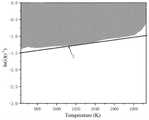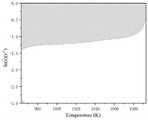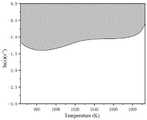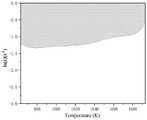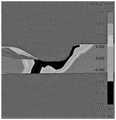CN112507567B - Method for predicting instability defect of forged microstructure of titanium alloy forging - Google Patents
Method for predicting instability defect of forged microstructure of titanium alloy forgingDownload PDFInfo
- Publication number
- CN112507567B CN112507567BCN202011528162.4ACN202011528162ACN112507567BCN 112507567 BCN112507567 BCN 112507567BCN 202011528162 ACN202011528162 ACN 202011528162ACN 112507567 BCN112507567 BCN 112507567B
- Authority
- CN
- China
- Prior art keywords
- instability
- titanium alloy
- forging
- buckling
- strain
- Prior art date
- Legal status (The legal status is an assumption and is not a legal conclusion. Google has not performed a legal analysis and makes no representation as to the accuracy of the status listed.)
- Active
Links
Images
Classifications
- G—PHYSICS
- G06—COMPUTING OR CALCULATING; COUNTING
- G06F—ELECTRIC DIGITAL DATA PROCESSING
- G06F30/00—Computer-aided design [CAD]
- G06F30/20—Design optimisation, verification or simulation
- G—PHYSICS
- G06—COMPUTING OR CALCULATING; COUNTING
- G06F—ELECTRIC DIGITAL DATA PROCESSING
- G06F17/00—Digital computing or data processing equipment or methods, specially adapted for specific functions
- G06F17/10—Complex mathematical operations
- G06F17/11—Complex mathematical operations for solving equations, e.g. nonlinear equations, general mathematical optimization problems
- G—PHYSICS
- G06—COMPUTING OR CALCULATING; COUNTING
- G06F—ELECTRIC DIGITAL DATA PROCESSING
- G06F17/00—Digital computing or data processing equipment or methods, specially adapted for specific functions
- G06F17/10—Complex mathematical operations
- G06F17/15—Correlation function computation including computation of convolution operations
- G—PHYSICS
- G06—COMPUTING OR CALCULATING; COUNTING
- G06F—ELECTRIC DIGITAL DATA PROCESSING
- G06F30/00—Computer-aided design [CAD]
- G06F30/20—Design optimisation, verification or simulation
- G06F30/28—Design optimisation, verification or simulation using fluid dynamics, e.g. using Navier-Stokes equations or computational fluid dynamics [CFD]
- G—PHYSICS
- G06—COMPUTING OR CALCULATING; COUNTING
- G06F—ELECTRIC DIGITAL DATA PROCESSING
- G06F2111/00—Details relating to CAD techniques
- G06F2111/10—Numerical modelling
- G—PHYSICS
- G06—COMPUTING OR CALCULATING; COUNTING
- G06F—ELECTRIC DIGITAL DATA PROCESSING
- G06F2113/00—Details relating to the application field
- G06F2113/08—Fluids
- G—PHYSICS
- G06—COMPUTING OR CALCULATING; COUNTING
- G06F—ELECTRIC DIGITAL DATA PROCESSING
- G06F2119/00—Details relating to the type or aim of the analysis or the optimisation
- G06F2119/08—Thermal analysis or thermal optimisation
- G—PHYSICS
- G06—COMPUTING OR CALCULATING; COUNTING
- G06F—ELECTRIC DIGITAL DATA PROCESSING
- G06F2119/00—Details relating to the type or aim of the analysis or the optimisation
- G06F2119/14—Force analysis or force optimisation, e.g. static or dynamic forces
Landscapes
- Engineering & Computer Science (AREA)
- Physics & Mathematics (AREA)
- General Physics & Mathematics (AREA)
- Theoretical Computer Science (AREA)
- Mathematical Physics (AREA)
- Pure & Applied Mathematics (AREA)
- Mathematical Analysis (AREA)
- Mathematical Optimization (AREA)
- Computational Mathematics (AREA)
- General Engineering & Computer Science (AREA)
- Data Mining & Analysis (AREA)
- Algebra (AREA)
- Geometry (AREA)
- Computing Systems (AREA)
- Evolutionary Computation (AREA)
- Computer Hardware Design (AREA)
- Databases & Information Systems (AREA)
- Software Systems (AREA)
- Fluid Mechanics (AREA)
- Operations Research (AREA)
- Forging (AREA)
- Investigating Or Analyzing Materials Using Thermal Means (AREA)
Abstract
Translated fromChineseDescription
Translated fromChinese技术领域technical field
本发明属于钛合金锻造技术领域,尤其涉及一种钛合金锻件锻造微观组织失稳缺陷预测方法。The invention belongs to the technical field of titanium alloy forging, and in particular relates to a method for predicting instability defects of microstructures in forging of titanium alloy forgings.
背景技术Background technique
钛合金具有优良的综合力学性能,广泛地应用于航空航天等领域。为了获得所需的宏观结构形状尺寸和优良的微观组织状态,热锻是钛合金重要的成型工艺,热锻过程中,受变形工艺参数和模具结构的影响,钛合金易产生微观裂纹、绝热剪切带等微观失稳缺陷,对锻件的力学性能影响极大。因此,预测热锻过程中的微观失稳缺陷对提高锻件组织稳定性和力学性能具有重要的意义。现有的研究主要集中在构建钛合金失稳缺陷预测的理论模型,并未能将理论模型有效的应用于实际中用于对锻件进行具体预测,无法解决具体工程实际应用问题。Titanium alloys have excellent comprehensive mechanical properties and are widely used in aerospace and other fields. In order to obtain the required macroscopic shape and size and excellent microstructure, hot forging is an important forming process for titanium alloys. During hot forging, due to the influence of deformation process parameters and die structure, titanium alloys are prone to microcracks, adiabatic shearing Microscopic instability defects such as cutting strips have a great impact on the mechanical properties of forgings. Therefore, predicting microscopic instability defects during hot forging is of great significance for improving the microstructure stability and mechanical properties of forgings. The existing research mainly focuses on the construction of theoretical models for the prediction of buckling defects of titanium alloys, and the theoretical models cannot be effectively applied in practice to make specific predictions for forgings, and they cannot solve the practical application problems of specific projects.
发明内容SUMMARY OF THE INVENTION
针对上述现有技术的不足,本发明所要解决的技术问题是:如何提供一种钛合金锻件锻造微观组织失稳缺陷预测方法,能够实现对锻造过程中钛合金微观组织失稳缺陷的有效预测,用于指导锻件的锻造成型。In view of the above-mentioned deficiencies of the prior art, the technical problem to be solved by the present invention is: how to provide a method for predicting the instability defect of the microstructure of titanium alloy forgings, which can realize the effective prediction of the instability defect of the microstructure of the titanium alloy in the forging process, Used to guide the forging shape of forgings.
为了解决上述技术问题,本发明采用了如下的技术方案:In order to solve the above-mentioned technical problems, the present invention adopts the following technical solutions:
一种钛合金锻件锻造微观组织失稳缺陷预测方法,包括以下步骤:A method for predicting instability defects of forging microstructure of titanium alloy forgings, comprising the following steps:
步骤(1)、将钛合金锻件制成试样,在热模拟试验机上对其进行不同温度T、应变速率和应变条件下的热压缩试验,获取高温流动应力σ数据,其中温度范围T为700-1100℃,应变速率范围为0.01s-1-10s-1,应变范围为0-0.91;Step (1), the titanium alloy forgings are made into samples, and they are subjected to different temperatures T and strain rates on a thermal simulation testing machine. and hot compression test under strain conditions to obtain high temperature flow stress σ data, where the temperature range T is 700-1100 ° C, the strain rate The range is 0.01s-1 -10s-1 and the strain range is 0-0.91;
步骤(2)、基于公式(1)求解钛合金的应变速率敏感指数m,基于公式(2)求解功率耗散效率η,基于公式(3)求解失稳判据ξ,其中所述公式(1)、(2)、(3)分别为:Step (2): Calculate the strain rate sensitivity index m of the titanium alloy based on the formula (1), calculate the power dissipation efficiency η based on the formula (2), and solve the instability criterion ξ based on the formula (3), wherein the formula (1) ), (2), (3) are:
ξ=2m-η (3)ξ=2m-η (3)
式中,α2、α3、α4为材料常数,通过三次多项式函数拟合求得;In the formula, α2 , α3 , α4 are material constants, which are obtained by fitting a cubic polynomial function;
步骤(3)、以温度T为横坐标、应变速率的对数为纵坐标绘制多幅失稳图,每幅失稳图对应一个应变条件,在每幅失稳图上以温度和应变速率所对应的点作为失稳判据ξ,通过步骤(2)计算每个温度、应变速率所对应的失稳判据ξ值,若ξ小于0,则该温度、应变速率及应变条件下试样失稳,将所有ξ小于0的点连起来形成失稳区;Step (3), take temperature T as abscissa, strain rate The logarithm of y is the ordinate to draw multiple buckling graphs, each buckling graph corresponds to a strain condition, and the point corresponding to the temperature and strain rate is used as the buckling criterion ξ on each buckling graph, through step (2) ) Calculate the instability criterion ξ value corresponding to each temperature and strain rate. If ξ is less than 0, the sample is unstable under the temperature, strain rate and strain conditions, and all points where ξ is less than 0 are connected to form instability Area;
步骤(4)、将步骤(3)中多幅失稳图进行叠加,以将多个失稳区进行叠加,并线性拟合叠加后的失稳区下边界形成失稳判断函数f(x,y),其中x为失稳图的横坐标,y为失稳图的纵坐标,若f(x,y)>0,则x、y对应温度和应变速率条件下出现失稳;In step (4), the multiple instability graphs in step (3) are superimposed to superimpose multiple instability regions, and the lower boundary of the superposed instability region is linearly fitted to form the instability judgment function f(x, y), where x is the abscissa of the buckling diagram, and y is the ordinate of the buckling diagram, if f(x,y)>0, then the instability occurs under the conditions of temperature and strain rate corresponding to x and y;
步骤(5)、通过编程将失稳判断函数f(x,y)写入数值软件中,并在模拟钛合金锻件热锻时,调用失稳判断函数f(x,y)计算钛合金锻件是否出现失稳现象。Step (5): Write the instability judgment function f(x,y) into the numerical software through programming, and call the instability judgment function f(x,y) to calculate whether the titanium alloy forging is hot when simulating the hot forging of the titanium alloy forging. Instability occurs.
作为优化,在步骤(4)中拟合叠加后的失稳区下边界形成失稳判断函数f(x,y)时,在失稳区下边界上选取两个点,使失稳区全部位于该两点连线上方;该两点确定的直线函数中与横坐标夹角最小的一条即为失稳判断函数f(x,y),分别记为(x1,y1)、(x2,y2),设y1=ax1+b,y2=ax2+b,求解得出a=(y1-y2)/(x1-x2),b=y1-(y1-y2)x1/(x1-x2),可得所以可得其中x1≠x2,y1≠y2。As an optimization, when the instability judgment function f(x, y) is formed by fitting the superposed lower boundary of the instability region in step (4), two points are selected on the lower boundary of the instability region so that all the instability regions are located in the lower boundary of the instability region. Above the line connecting the two points; the one with the smallest angle between the straight line functions determined by the two points and the abscissa is the instability judgment function f(x, y), which are respectively recorded as (x1 , y1 ), (x2 , y2 ), set y1 =ax1 +b, y2 =ax2 +b, solve a=(y1 -y2 )/(x1 -x2 ), b=y1 -(y1 -y2 )x1 /(x1 -x2 ), we get So available where x1 ≠x2 and y1 ≠y2 .
本发明与现有技术相比具有以下有益效果:本发明通过研究失稳图,将多个应变条件下的失稳图进行叠加,相应的失稳区同步进行了叠加,然后通过线性拟合叠加后的失稳区的下边界构建失稳判断函数,失稳判断函数值大于0的地方位于失稳区内,表示该温度、应变速率条件下钛合金出现失稳现象,并将该失稳判断函数进行编程二次开发,在数值模拟软件中模拟锻件热锻时,调用该失稳判断函数进行计算,有效预测出锻件上哪些区域出现失稳现象,失稳缺陷出现时的温度和应变速率等条件,并在模拟软件中可视化表现出来,可用于指导锻件的锻造成型。Compared with the prior art, the present invention has the following beneficial effects: by studying the instability diagram, the present invention superimposes the instability diagrams under multiple strain conditions, the corresponding instability regions are synchronously superimposed, and then superimposed by linear fitting The instability judgment function is constructed at the lower boundary of the latter buckling zone. The place where the value of the buckling judgment function is greater than 0 is located in the buckling zone, which means that the titanium alloy is unstable under the conditions of temperature and strain rate. The function is used for secondary development of programming. When simulating hot forging in the numerical simulation software, the instability judgment function is called for calculation, which effectively predicts which areas on the forging appear instability, the temperature and strain rate when the instability defect occurs, etc. conditions, and visualized in the simulation software, which can be used to guide the forging of forgings.
附图说明Description of drawings
图1是本发明叠加后的失稳图;Fig. 1 is the instability diagram after superposition of the present invention;
图2是本发明在0.3应变条件下的失稳图;Fig. 2 is the instability diagram of the present invention under the condition of 0.3 strain;
图3是本发明在0.6应变条件下的失稳图;Fig. 3 is the instability diagram of the present invention under the condition of 0.6 strain;
图4是本发明在0.9应变条件下的失稳图;Fig. 4 is the instability diagram of the present invention under the condition of 0.9 strain;
图5是本发明实施例中锻件的失稳预测图。Fig. 5 is a graph showing the instability prediction of the forging in the embodiment of the present invention.
具体实施方式Detailed ways
下面结合附图对本发明作进一步的详细说明。The present invention will be further described in detail below in conjunction with the accompanying drawings.
具体实施时:参见图1至图4,一种钛合金锻件锻造微观组织失稳缺陷预测方法,包括以下步骤:In specific implementation: referring to Figures 1 to 4, a method for predicting instability defects of titanium alloy forging microstructures, including the following steps:
步骤(1)、将钛合金锻件制成试样,在热模拟试验机上对其进行不同温度T、应变速率和应变条件下的热压缩试验,获取高温流动应力σ数据,其中温度范围T为700-1100℃,应变速率范围为0.01s-1-10s-1,应变范围为0-0.91;Step (1), the titanium alloy forgings are made into samples, and they are subjected to different temperatures T and strain rates on a thermal simulation testing machine. and hot compression test under strain conditions to obtain high temperature flow stress σ data, where the temperature range T is 700-1100 ° C, the strain rate The range is 0.01s-1 -10s-1 and the strain range is 0-0.91;
步骤(2)、基于公式(1)求解钛合金的应变速率敏感指数m,基于公式(2)求解功率耗散效率η,基于公式(3)求解失稳判据ξ,其中所述公式(1)、(2)、(3)分别为:Step (2): Calculate the strain rate sensitivity index m of the titanium alloy based on the formula (1), calculate the power dissipation efficiency η based on the formula (2), and solve the instability criterion ξ based on the formula (3), wherein the formula (1) ), (2), (3) are:
ξ=2m-η (3)ξ=2m-η (3)
式中,α2、α3、α4为材料常数,流动应力的对数和应变速率的对数通过热压缩试验已知,在不同应变条件下得到两者的对应关系,通过如origin软件对其进行三次多项式函数拟合即可求解相关参数值;In the formula, α2 , α3 , α4 are the material constants, the logarithm of the flow stress and the logarithm of the strain rate are known through the hot compression test, and the corresponding relationship between the two can be obtained under different strain conditions. It can solve the relevant parameter values by fitting a cubic polynomial function;
步骤(3)、以温度T为横坐标、应变速率的对数为纵坐标绘制多幅失稳图,每幅失稳图对应一个应变条件,在每幅失稳图上以温度和应变速率所对应的点作为失稳判据ξ,通过步骤(2)计算每个温度、应变速率所对应的失稳判据ξ值,若ξ小于0,则该温度、应变速率及应变条件下试样失稳,将所有ξ小于0的点连起来形成失稳区;Step (3), take temperature T as abscissa, strain rate The logarithm of y is the ordinate to draw multiple buckling graphs, each buckling graph corresponds to a strain condition, and the point corresponding to the temperature and strain rate is used as the buckling criterion ξ on each buckling graph, through step (2) ) Calculate the instability criterion ξ value corresponding to each temperature and strain rate. If ξ is less than 0, the sample is unstable under the temperature, strain rate and strain conditions, and all points where ξ is less than 0 are connected to form instability Area;
步骤(4)、将步骤(3)中多幅失稳图进行叠加,以将多个失稳区进行叠加,并线性拟合叠加后的失稳区下边界形成失稳判断函数f(x,y),其中x为失稳图的横坐标,y为失稳图的纵坐标,若f(x,y)>0,则x、y对应温度和应变速率条件下出现失稳;In step (4), the multiple instability graphs in step (3) are superimposed to superimpose multiple instability regions, and the lower boundary of the superposed instability region is linearly fitted to form the instability judgment function f(x, y), where x is the abscissa of the buckling diagram, and y is the ordinate of the buckling diagram, if f(x,y)>0, then the instability occurs under the conditions of temperature and strain rate corresponding to x and y;
步骤(5)、通过编程将失稳判断函数f(x,y)写入数值软件中,并在模拟钛合金锻件热锻时,调用失稳判断函数f(x,y)计算钛合金锻件是否出现失稳现象。Step (5): Write the instability judgment function f(x,y) into the numerical software through programming, and call the instability judgment function f(x,y) to calculate whether the titanium alloy forging is hot when simulating the hot forging of the titanium alloy forging. Instability occurs.
实施时,在步骤(4)中拟合叠加后的失稳区下边界形成失稳判断函数f(x,y)时,在失稳区下边界上选取两个点,使失稳区全部位于该两点连线上方;该两点确定的直线函数中与横坐标夹角最小的一条即为失稳判断函数f(x,y),分别记为(x1,y1)、(x2,y2),设y1=ax1+b,y2=ax2+b,求解得出a=(y1-y2)/(x1-x2),b=y1-(y1-y2)x1/(x1-x2),可得所以可得其中x1≠x2,y1≠y2。During the implementation, when the instability judgment function f(x, y) is formed by fitting the superposed lower boundary of the instability region in step (4), two points are selected on the lower boundary of the instability region, so that all the instability regions are located in the lower boundary of the instability region. Above the line connecting the two points; the one with the smallest angle between the straight line functions determined by the two points and the abscissa is the instability judgment function f(x, y), which are respectively recorded as (x1 , y1 ), (x2 , y2 ), set y1 =ax1 +b, y2 =ax2 +b, solve a=(y1 -y2 )/(x1 -x2 ), b=y1 -(y1 -y2 )x1 /(x1 -x2 ), we get So available where x1 ≠x2 and y1 ≠y2 .
实施时,为节省资源,应变条件选0.3、0.6和0.9进行试验,将此应变条件下的失稳图进行叠加,对叠加后的失稳区下边界进行线性拟合,本申请在失稳区下边界上选取两个点,使失稳区全部位于该两点连线上方,该两点确定的直线函数中与横坐标夹角最小的一条即为失稳判断函数1,是因为两个点即可确定一条直线,可以最为便捷的拟合出下边界,选取夹角最小的一条直线,可以尽可能的降低误差,若需要完美的拟合出下边界,则拟合函数非常复杂,计算过程十分冗长,不宜操作。而当失稳判断函数确定后,通过Fortran语言将其进行编程二次开发,写入DEFORM数值模拟软件中以供调用,对某钛合金锻件进行数值模拟时,需先用三维建模软件如catia对锻件进行建模并导入模拟软件中,在模拟前输入开锻温度和成型速度,模拟时,锻件上每个节点的温度变化和应变速率变化都可以通过模拟软件计算出来,此时,再调用失稳判断函数对每个节点进行计算,就可算出锻件上哪些区域出现失稳现象,失稳缺陷出现时的温度和应变速率等条件,并在模拟软件中可视化表现出来,从而预测出锻件失稳缺陷,为锻件的锻造成型提供指导,参见图5,乃是某航空锻件采用本方法进行预测最后在DEFORM软件中可视化显示出来的图像,图中值等于-1的点即为失稳区域。During implementation, in order to save resources, strain conditions of 0.3, 0.6 and 0.9 were selected for testing, and the instability map under this strain condition was superimposed, and the lower boundary of the superimposed instability region was linearly fitted. This application is in the instability region. Two points are selected on the lower boundary, so that the instability area is all located above the line connecting the two points. The line function determined by the two points with the smallest angle with the abscissa is the instability judgment function 1, because the two points A straight line can be determined, and the lower boundary can be fitted most conveniently. Selecting a straight line with the smallest included angle can reduce the error as much as possible. If the lower boundary needs to be perfectly fitted, the fitting function is very complicated and the calculation process Very verbose and not suitable for operation. When the instability judgment function is determined, it will be programmed for secondary development through Fortran language, and written into DEFORM numerical simulation software for calling. When numerical simulation of a titanium alloy forging is performed, three-dimensional modeling software such as catia must be used first. Model the forging and import it into the simulation software. Input the forging temperature and forming speed before the simulation. During the simulation, the temperature change and strain rate change of each node on the forging can be calculated by the simulation software. At this time, call the The instability judgment function calculates each node to calculate which areas on the forging appear instability, the temperature and strain rate when the instability defect occurs, and visualize it in the simulation software, so as to predict the failure of the forging. The stability defect provides guidance for the forging forming of the forging. See Figure 5. It is an image of an aviation forging predicted by this method and finally visualized in the DEFORM software. The point with a value equal to -1 in the figure is the instability area.
尽管已经示出和描述了本发明的实施例,对于本领域的普通技术人员而言,可以在不脱离本发明的原理和基础的情况下对这些实施例进行多种变化、修改、替换和变型,本发明的范围由所附加权利要求及其等同物限定,因此本发明的实施例只是针对本发明的一个说明示例,无论从哪一点来看本发明的实施例都不构成对本发明的限制。Although embodiments of the present invention have been shown and described, various changes, modifications, substitutions and alterations can be made in these embodiments by those skilled in the art without departing from the principle and basis of this invention , the scope of the present invention is defined by the appended claims and their equivalents, so the embodiments of the present invention are only an illustrative example of the present invention, and the embodiments of the present invention do not limit the present invention from any point of view.
Claims (2)
Translated fromChinesePriority Applications (1)
| Application Number | Priority Date | Filing Date | Title |
|---|---|---|---|
| CN202011528162.4ACN112507567B (en) | 2020-12-22 | 2020-12-22 | Method for predicting instability defect of forged microstructure of titanium alloy forging |
Applications Claiming Priority (1)
| Application Number | Priority Date | Filing Date | Title |
|---|---|---|---|
| CN202011528162.4ACN112507567B (en) | 2020-12-22 | 2020-12-22 | Method for predicting instability defect of forged microstructure of titanium alloy forging |
Publications (2)
| Publication Number | Publication Date |
|---|---|
| CN112507567A CN112507567A (en) | 2021-03-16 |
| CN112507567Btrue CN112507567B (en) | 2022-08-05 |
Family
ID=74923094
Family Applications (1)
| Application Number | Title | Priority Date | Filing Date |
|---|---|---|---|
| CN202011528162.4AActiveCN112507567B (en) | 2020-12-22 | 2020-12-22 | Method for predicting instability defect of forged microstructure of titanium alloy forging |
Country Status (1)
| Country | Link |
|---|---|
| CN (1) | CN112507567B (en) |
Families Citing this family (1)
| Publication number | Priority date | Publication date | Assignee | Title |
|---|---|---|---|---|
| CN115423218B (en)* | 2022-11-02 | 2023-03-24 | 江苏新恒基特种装备股份有限公司 | Prediction method and system for forge piece defect elimination process |
Citations (3)
| Publication number | Priority date | Publication date | Assignee | Title |
|---|---|---|---|---|
| CN102708303A (en)* | 2012-06-12 | 2012-10-03 | 湖南大学 | Method for simulating and predicting transient thermoforming limit of ultra-high strength steel |
| CN106599446A (en)* | 2016-12-10 | 2017-04-26 | 燕山大学 | Method and system for establishing wrinkling instability limit diagram of shell material |
| CN109918785A (en)* | 2019-03-07 | 2019-06-21 | 南京航空航天大学 | A prediction and control method for hot forming of large and complex thin-walled titanium alloy components |
Family Cites Families (4)
| Publication number | Priority date | Publication date | Assignee | Title |
|---|---|---|---|---|
| US8286111B2 (en)* | 2004-03-11 | 2012-10-09 | Gradient Design Automation Inc. | Thermal simulation using adaptive 3D and hierarchical grid mechanisms |
| CN101201307A (en)* | 2006-12-13 | 2008-06-18 | 中国科学院金属研究所 | A Method of Automatically Drawing Material Thermal Processing Diagram |
| US10983514B2 (en)* | 2016-05-09 | 2021-04-20 | Strong Force Iot Portfolio 2016, Llc | Methods and systems for equipment monitoring in an Internet of Things mining environment |
| CN108595862B (en)* | 2018-05-02 | 2022-03-25 | 西北工业大学 | An optimization method for forging process parameters of 300M steel based on instability analysis |
- 2020
- 2020-12-22CNCN202011528162.4Apatent/CN112507567B/enactiveActive
Patent Citations (3)
| Publication number | Priority date | Publication date | Assignee | Title |
|---|---|---|---|---|
| CN102708303A (en)* | 2012-06-12 | 2012-10-03 | 湖南大学 | Method for simulating and predicting transient thermoforming limit of ultra-high strength steel |
| CN106599446A (en)* | 2016-12-10 | 2017-04-26 | 燕山大学 | Method and system for establishing wrinkling instability limit diagram of shell material |
| CN109918785A (en)* | 2019-03-07 | 2019-06-21 | 南京航空航天大学 | A prediction and control method for hot forming of large and complex thin-walled titanium alloy components |
Also Published As
| Publication number | Publication date |
|---|---|
| CN112507567A (en) | 2021-03-16 |
Similar Documents
| Publication | Publication Date | Title |
|---|---|---|
| EP3944125B1 (en) | Method and system for manufacturing a heat exchanger for supercritical pressure fluid | |
| CN114065662B (en) | Method suitable for rapidly predicting airfoil flow field with variable grid topology | |
| CN114818437B (en) | Optimization method of isothermal forging process of titanium alloy blisk | |
| CN105373683A (en) | Prediction method for microstructure evolution law of 20CrMnTiH steel in thermal deformation process | |
| CN106777482A (en) | A kind of structure Multidisciplinary design optimization method based on mesh parameterization | |
| CN104978456A (en) | General valve design optimization method | |
| CN108875213A (en) | A kind of reactor core thermal-hydraulic multiscale analysis method | |
| CN115859851B (en) | Calculation method for conjugate heat transfer of liquid metal coupling supercritical carbon dioxide | |
| CN116502358A (en) | A Stress Prediction System and Method for Precision Castings of Turbine Blades Based on Digital Twins | |
| CN118335211B (en) | A method for constructing a dynamic thickening flame model optimized by artificial intelligence | |
| CN111666663A (en) | SLM thermal stress rapid calculation method | |
| CN114780909A (en) | Partial differential equation solving method and system based on physical information neural network | |
| CN104657565B (en) | Design method of hot working die near surface water channel | |
| CN115470726A (en) | A fast prediction method for hypersonic inlet flow field based on deep learning | |
| CN112507567B (en) | Method for predicting instability defect of forged microstructure of titanium alloy forging | |
| CN118395613A (en) | An intercooler optimization design method based on porous media model | |
| CN115563736B (en) | Turbine blade arc material-increasing real-time temperature field prediction method | |
| CN116579162A (en) | A temperature field, defect analysis and stress field simulation method for directional cast crystal blades | |
| CN114398728B (en) | Mold temperature simulation analysis method considering cooling water temperature change | |
| CN119004709B (en) | An integrated gradient optimization method for internal and external flow of aircraft based on hybrid parameterization | |
| CN113536640B (en) | Optimization design method for internal flow channel structure of air distributor based on orthogonal test | |
| CN112836297B (en) | Alloy casting size accurate regulation and control method based on integrated calculation and tolerance design | |
| CN118595547A (en) | A prediction method for fretting wear performance of turbine disk grooves based on associated wire cutting process parameters | |
| CN117390958A (en) | A transient calculation method for pressurized water reactors based on deep learning | |
| CN113312727B (en) | Efficient online design optimization method for nuclear power station valve |
Legal Events
| Date | Code | Title | Description |
|---|---|---|---|
| PB01 | Publication | ||
| PB01 | Publication | ||
| SE01 | Entry into force of request for substantive examination | ||
| SE01 | Entry into force of request for substantive examination | ||
| GR01 | Patent grant | ||
| GR01 | Patent grant | ||
| CP03 | Change of name, title or address | ||
| CP03 | Change of name, title or address | Address after:No. 20, East Road, University City, Chongqing, Shapingba District, Chongqing Patentee after:Chongqing University of science and technology Country or region after:China Address before:No. 20, East Road, University City, Chongqing, Shapingba District, Chongqing Patentee before:Chongqing University of Science & Technology Country or region before:China | |
| EE01 | Entry into force of recordation of patent licensing contract | ||
| EE01 | Entry into force of recordation of patent licensing contract | Application publication date:20210316 Assignee:Chongqing Hengrui Jinding Induction Technology Co.,Ltd. Assignor:Chongqing University of science and technology Contract record no.:X2025980013254 Denomination of invention:A method for predicting instability defects in the forging microstructure of a titanium alloy forging Granted publication date:20220805 License type:Common License Record date:20250711 |
